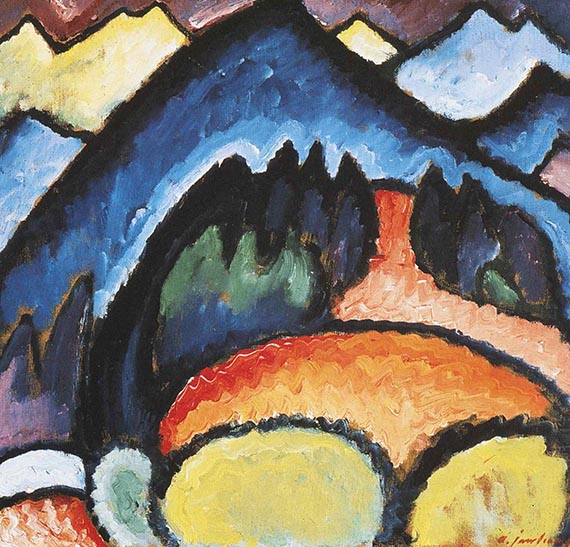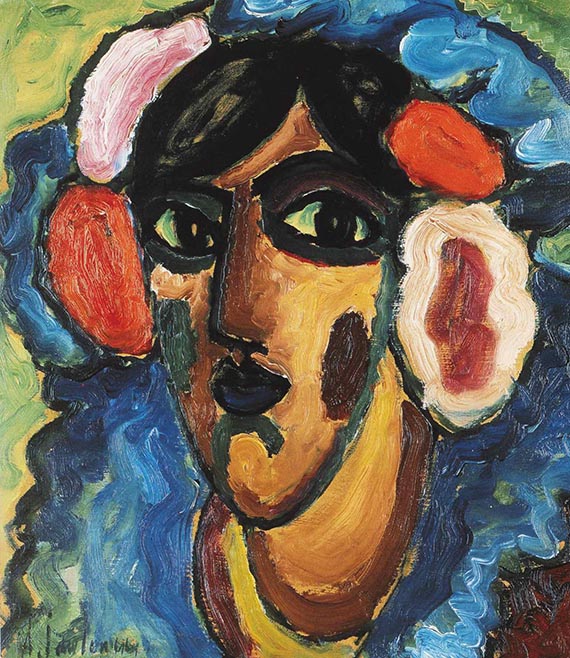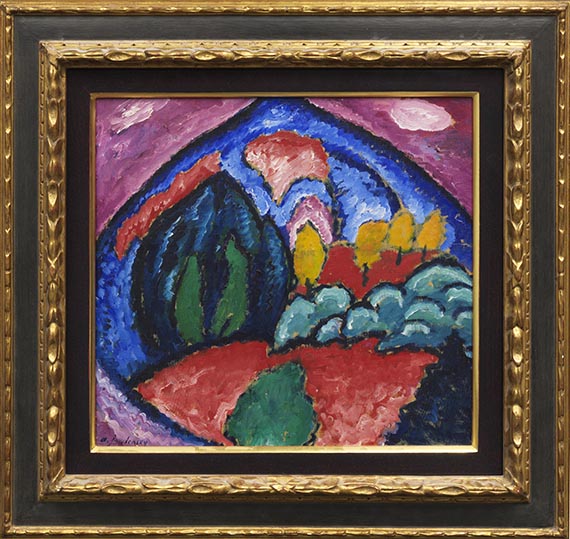15
Alexej von Jawlensky
Berge in Oberstdorf, 1912.
Oil on cardboard
Estimation:
€ 700,000 / $ 812,000 Résultat:
€ 1,076,500 / $ 1,248,740 ( frais d'adjudication compris)
Berge in Oberstdorf. 1912.
Oil on cardboard.
Signed in the lower left. Signed in the lower right on the reverse and inscribed "N 10 / V.L. [= Vorkriegslandschaft] Berge" in the center, as well as inscribed ‘Obersdorf [sic] 1912’ by Lisa Kümmel in the course of taking inventory of the studio collection (1937–1939), and subsequently added ‘Berge in’ by a hand other than that of the artist. 48.5 x 52.4 cm (19 x 20.6 in). [JS].
• One of Jawlensky's most powerful expressionist landscapes from the time of the “Blue Rider.”
• Jawlensky at the peak of his creativity: he attained a maximum liberation from nature by painting freely based on color and form.
• Unique and ground-breaking, a mystically stylized landscape, created at the same time as his famous heads, the vision of a landscape takes on the character of a sculpture.
• Museum-quality gem: the closely related landscape “Oberstdorf” (1912) has held the international top price for a landscape painting by the artist since 2013 (source: artprice.com). No landscape of this quality has been offered since.
• Comparable works are part of international museum collections.
• Outstanding and complete provenance: from the possession of Jawlensky's confidante Lisa Kümmel and part of the significant Expressionism collection of Hermann Gerlinger, Würzburg, for over 50 years.
The work is documented in the artist's photo archive with the title "Oberstdorf".
We are grateful to Ms Angelica Jawlensky-Bianconi, Alexej von Jawlensky Archive S.A., Muralto, Switzerland, for her kind support in cataloging this lot.
PROVENANCE: Studio of the artist (until the 1920s).
Lisa Kümmel (1897-1944), Wiesbaden (obtained directly from the artist in the 1920s).
Karl Kümmel, Wiesbaden (inherited from the above in 1944).
Josefine Eyerle (1988-1952), Wiesbaden (presumably obtained directly from the above or from her estate, family property until 1971: Sotheby's London).
Galerie Aenne Abels, Cologne (presumably acquired directly from the above in 1971).
Art dealer Dr. Rainer Horstmann (from the above in 1972).
Professor Hermann Gerlinger Collection, Würzburg (acquired from the above in June 1972).
EXHIBITION: A Futuristák és Expressionisták Kiállitásának, Nemzeti Szalon, Budapest, January- February 1913, no. 53 or no. 68 (not illustrated, shown under the title “Mountains”).
Alexej von Jawlensky, Kunsthütte Chemnitz, Chemnitz 1923 (no cat.).
Alexej von Jawlensky, Kunstsalon Schaller, Stuttgart 1923 (no cat.).
Alexej von Jawlensky, Städtische Galerie im Lenbachhaus, Munich, February 23 - April 17, 1983 / Staatliche Kunsthalle, Baden-Baden, May 1 - June 26, 1983, cat. no. 103 (illustrated, p. 210, with exhibition labels on the frame)
Alexej von Jawlensky, Pinacoteca Comunale, Casa Rusca, Locarno, September 3 - November 19, 1989, cat. no. 52 (illustrated on p. 89, with the exhibition label on the frame).
LITERATURE: Maria Jawlensky, Lucia Pieroni-Jawlensky, Angelica Jawlensky, Alexej von Jawlensky. Catalogue Raisonné of the Oil Paintings, vol. 1: 1890-1914, Munich 1991, cat. rais. no. 536 (illustrated on p. 422).
Clemens Weiler, Köpfe - Gesichte - Meditationen, Hanau 1970, catalogue raisonné no. 1142 (not illustrated, listed here as “No. 10/1912 Oberstdorf (Berg)”)
-
Sotheby's London, February 1, 1971, lot 85 A (inscribed with the lot number in chalk on the reverse)
Irina Devjatarova, Alexej Jawlensky. Gemälde aus den Sammlungen des Kunstmuseums M.A. Wrubel und des städtischen historischen-ethnographischen Museum Omsk, Omsk 2004, Russian edition, ill. p. 14.
Thomas Bauer-Friedrich, Dokumentation zur Jawlensky-Ausstellung, 29 March - 13 May 1923, shown by Kunsthütte zu Chemnitz at the Museum am Theaterplatz, in: Jawlensky neu gesehen, exhib. cat. Chemnitz 2013, p. 237 (with fig. 78).
“For me, the summer represented a major development in my art. I painted my best landscapes and large figurative works in vibrant, non-naturalistic, and immaterial colors. I used a lot of red, blue, orange, cadmium yellow, chrome oxide green. The forms strongly contoured with Prussian blue and emanated an inner ecstasy.”
Alexej von Jawlensky, Lebenserinnerungen, quoted in: Clemens Weiler, Jawlensky. Köpfe - Gesichte - Meditationen, Hanau 1970, p. 112.
Oil on cardboard.
Signed in the lower left. Signed in the lower right on the reverse and inscribed "N 10 / V.L. [= Vorkriegslandschaft] Berge" in the center, as well as inscribed ‘Obersdorf [sic] 1912’ by Lisa Kümmel in the course of taking inventory of the studio collection (1937–1939), and subsequently added ‘Berge in’ by a hand other than that of the artist. 48.5 x 52.4 cm (19 x 20.6 in). [JS].
• One of Jawlensky's most powerful expressionist landscapes from the time of the “Blue Rider.”
• Jawlensky at the peak of his creativity: he attained a maximum liberation from nature by painting freely based on color and form.
• Unique and ground-breaking, a mystically stylized landscape, created at the same time as his famous heads, the vision of a landscape takes on the character of a sculpture.
• Museum-quality gem: the closely related landscape “Oberstdorf” (1912) has held the international top price for a landscape painting by the artist since 2013 (source: artprice.com). No landscape of this quality has been offered since.
• Comparable works are part of international museum collections.
• Outstanding and complete provenance: from the possession of Jawlensky's confidante Lisa Kümmel and part of the significant Expressionism collection of Hermann Gerlinger, Würzburg, for over 50 years.
The work is documented in the artist's photo archive with the title "Oberstdorf".
We are grateful to Ms Angelica Jawlensky-Bianconi, Alexej von Jawlensky Archive S.A., Muralto, Switzerland, for her kind support in cataloging this lot.
PROVENANCE: Studio of the artist (until the 1920s).
Lisa Kümmel (1897-1944), Wiesbaden (obtained directly from the artist in the 1920s).
Karl Kümmel, Wiesbaden (inherited from the above in 1944).
Josefine Eyerle (1988-1952), Wiesbaden (presumably obtained directly from the above or from her estate, family property until 1971: Sotheby's London).
Galerie Aenne Abels, Cologne (presumably acquired directly from the above in 1971).
Art dealer Dr. Rainer Horstmann (from the above in 1972).
Professor Hermann Gerlinger Collection, Würzburg (acquired from the above in June 1972).
EXHIBITION: A Futuristák és Expressionisták Kiállitásának, Nemzeti Szalon, Budapest, January- February 1913, no. 53 or no. 68 (not illustrated, shown under the title “Mountains”).
Alexej von Jawlensky, Kunsthütte Chemnitz, Chemnitz 1923 (no cat.).
Alexej von Jawlensky, Kunstsalon Schaller, Stuttgart 1923 (no cat.).
Alexej von Jawlensky, Städtische Galerie im Lenbachhaus, Munich, February 23 - April 17, 1983 / Staatliche Kunsthalle, Baden-Baden, May 1 - June 26, 1983, cat. no. 103 (illustrated, p. 210, with exhibition labels on the frame)
Alexej von Jawlensky, Pinacoteca Comunale, Casa Rusca, Locarno, September 3 - November 19, 1989, cat. no. 52 (illustrated on p. 89, with the exhibition label on the frame).
LITERATURE: Maria Jawlensky, Lucia Pieroni-Jawlensky, Angelica Jawlensky, Alexej von Jawlensky. Catalogue Raisonné of the Oil Paintings, vol. 1: 1890-1914, Munich 1991, cat. rais. no. 536 (illustrated on p. 422).
Clemens Weiler, Köpfe - Gesichte - Meditationen, Hanau 1970, catalogue raisonné no. 1142 (not illustrated, listed here as “No. 10/1912 Oberstdorf (Berg)”)
-
Sotheby's London, February 1, 1971, lot 85 A (inscribed with the lot number in chalk on the reverse)
Irina Devjatarova, Alexej Jawlensky. Gemälde aus den Sammlungen des Kunstmuseums M.A. Wrubel und des städtischen historischen-ethnographischen Museum Omsk, Omsk 2004, Russian edition, ill. p. 14.
Thomas Bauer-Friedrich, Dokumentation zur Jawlensky-Ausstellung, 29 March - 13 May 1923, shown by Kunsthütte zu Chemnitz at the Museum am Theaterplatz, in: Jawlensky neu gesehen, exhib. cat. Chemnitz 2013, p. 237 (with fig. 78).
“For me, the summer represented a major development in my art. I painted my best landscapes and large figurative works in vibrant, non-naturalistic, and immaterial colors. I used a lot of red, blue, orange, cadmium yellow, chrome oxide green. The forms strongly contoured with Prussian blue and emanated an inner ecstasy.”
Alexej von Jawlensky, Lebenserinnerungen, quoted in: Clemens Weiler, Jawlensky. Köpfe - Gesichte - Meditationen, Hanau 1970, p. 112.
"Berge in Oberstdorf" – A captivating soulscape
Alexej von Jawlensky and Marianne von Werefkin spent the summer of 1912 in their holiday domicile in Oberstdorf, where they found inspiration for their work in the impressive mountain scenery surrounding them. In his memoirs, Jawlensky mentions this almost in passing: “I painted several mountain landscapes in Oberstdorf,” including this very unusual, almost mysterious mountain landscape. Along with his colorful still lifes and fabulous heads, this present work is, beyond doubt, one of the most impressive landscapes the artist made before the war broke out in 1914. In Oberstdorf, Jawlensky devoted himself to the variety of motifs that peaks, valleys, and Alpine pastures had to offer. His view of the mountain world is imbued with an esoteric and transcendental notion, reflecting the visible world and one inaccessible to the human senses. The holistic approach of the anthroposophist Rudolf Steiner (1861-1925) encouraged Jawlensky and Werefkin to adopt his reformist teachings regarding society and life. It inspired them to approach the world and their own psyche from a spiritual perspective and to unlock the occult potential in painting, which may have found expression in the form of the sphere in the present work. Alternatively, as Kandinsky would put it when he was teaching at the Bauhaus in the mid-1920s: “Not everything is visible and tangible, or – to phrase it better – the invisible and intangible lies underneath what is visible and tangible.” (Wassily Kandinsky: Punkt und Linie zu Fläche. Beitrag zur Analyse der malerischen Elemente. Bauhaus Bücher no. 9, Munich 1926, pp. 153f.)

Alexej von Jawlensky, Oberstdorf, 1912, oil on canvas, sold in 2013, since then the highest price paid for a landscape painting by Jawlensky.
The “mountain” theme did not become relevant for the artist only after his stay in Obersdorf; it was as early during the summer months of 1908 and 1909 that Jawlensky, along with Werefkin, Gabriele Münter, and Kandinsky, began painting the gentle hills around the town of Murnau am Staffelsee, situated in front an impressive landscape with the blue mountains in the background. He would remain faithful to this theme for several years, varying form and color and attaining an exceptional pictorial effect, as is the case here. As if embedded in a round form, like in a sphere, and surrounded by a purple-blue universe, a dreamlike, visionary Alpine landscape with dense bushes and isolated trees in autumn colors floats in front of blue mountains rendered in a palette that reflects the atmosphere of air and light. The artist's impulsivity determines the correlation between color and form, as does the application of the paint and the brushstroke. Jawlensky seeks to express calm and immersion in the lush blue towering mountains. The isolated trees with trunk and foliage appear as clear and simple forms, outlining an Alpine pasture. The work of art comes into being in “a mysterious, enigmatic, mystical way,” as Kandinsky mentions elsewhere in his 1926 pamphlet, reflecting on the creation of a painting. (Kandinsky, 1926, p. 136)
The use of colors and forms that Jawlensky chose in this work visualizes the overarching theme of energy and movement. The artist placed the trees on the mountain meadow in a rhythmical yet balanced arrangement in front of the mountains, making them a vital part of the composition despite their unassuming appearance. “Do not copy nature too closely. Art is an abstraction; draw on nature by observing it dreamily and think more about the creation than the result,” said Paul Cézanne. (John Rewald, Von van Gogh bis Gauguin. Die Geschichte des Nachimpressionismus, Cologne 1967, p.127). In this sense, one cannot help but feel that this Oberstdorf mountain landscape is reminiscent of his powerful pictures of 'Heads,' such as “Infanta,” from around the same time.

Alexej von Jawlensky, Infantin, 1912, oil on cardboard, private collection USA.
The “Blue Rider” – Expressionist painting as a “synthesis”
Jawlensky found inspiration for the unity of his compositions in 'Cloisonism,' a term coined by Gauguin that refers to an aesthetic quality in painting in which large areas of pure colors are outlined by black or colored lines: color, pictorial harmony, and inventiveness. In the founding document of the “Neue Künstlervereinigung München” (New Artists' Association Munich) from 1909, Kandinsky addressed the concept of “artistic synthesis,” which he describes as a “solution that currently unites an increasing number of artists spiritually [..]”. In the years leading up to World War I, a time crucial for his artistic development, Jawlensky distinguished himself through an open mind and a genuine ability to process the most diverse impulses without prejudice and to transform them into something entirely his own. He was no longer concerned with creating images, but rather, in line with the art theory of the “Blauer Reiter” and its institutional forerunner, the “Neue Künstlervereinigung München,” which was founded in 1909, with the color- and form-based expression of a spiritual and emotional feeling. Jawlensky, along with Wassily Kandinsky, Gabriele Münter, and Marianne von Werefkin, was one of the founding members of the “Neue Künstlervereinigung.” In its founding pamphlet from the spring of 1909, Kandinsky said: “We would like to draw your attention to an association of artists that came into being in January 1909 [..] We are guided by the idea that, in addition to external impressions from nature, the artist constantly gathers experiences in an inner world; and the search for artistic forms that express the interpenetration of all these experiences - forms that must be liberated from anything extraneous, in order to express nothing but what matters - in short, the quest for artistic synthesis [..]" (quoted from Annegret Hoberg / Helmut Friedel, Der Blaue Reiter und das Neue Bild, Munich/London/New York 1999, p. 30). When Jawlensky and Werefkin – along with Helene and her son Andreas – returned to Munich from the rejuvenating mountain air of Oberstdorf in early December 1912, they were surprised by the heated discussions among association members about the recently published book 'Das Neue Bild.' The art historian Otto Fischer, who was also a member of the 'Neue Künstlervereinigung,' had expressed positions about the group's painting in a book he had published that all members did not share. The struggle for modernism and its goals had become determining factors for Jawlensky's everyday life, and the artist had to assert his artistic position between the “Neue Künstlervereinigung München,” the “Blauer Reiter,” the “Sonderbund Westdeutscher Kunstfreunde und Künstler” in Cologne and the “Erster Deutscher Herbstsalon” in Berlin on the eve of the First World War. With his painting, however, he succeeded in affirming himself irrespective of the groups and inspired art lovers and patrons alike.
On the provenance – Jawlensky's close confidante Lisa Kümmel
To reward her devoted support, Lisa Kümmel received this extraordinary and magnificent mountain landscape as a gift from Jawlensky in the late 1920s. In 1927, Alexej von Jawlensky met the young, versatile, and educated artist, who, at barely 30 years of age, took care of all organizational matters related to his work until he died in 1941. In a letter to Ada and Emil Nolde from October 18, 1938, she described her work for Jawlensky as follows: “I am his friend in the best sense of the word and have known him for 12 years. I take care of all his business correspondence, including his private correspondence, look after his paintings, and do all the pasting, waxing, varnishing, etc.” (Helga Lukowsky, Jawlenskys Abendsonne. Der Maler und die Künstlerin Lisa Kümmel, Königstein i. Taunus 2000, p. 105) Her journal, which covers the period between 1936 and 1939 (Alexej von Jawlensky Archive, Muralto/CH), reveals that she visited the artist almost every day between 5 and 10 p.m. At Jawlensky's apartment at Beethovenstraße 9, she would clean his palette and brushes, take the Meditations he had made that day from the board on the easel, and mount new sheets the artist could work on during the night or the following day. She arranged his works, cataloged and categorized them, varnished or waxed them as agreed with the artist, mounted them on cardboard, attached labels and numbers, and framed them for sales and exhibitions. The human affection for Jawlensky during these years was immeasurable, not to mention the support from his wife Helene and son Andreas. In 1936/37, Jawlensky dictated his memoirs to Lisa Kümmel and compiled the so-called workshop inventory, a list of all the works in the artist's studio. After the artist died in 1941, Lisa Kümmel continued to take care of his estate; she died in November 1944. [MvL]
15
Alexej von Jawlensky
Berge in Oberstdorf, 1912.
Oil on cardboard
Estimation:
€ 700,000 / $ 812,000 Résultat:
€ 1,076,500 / $ 1,248,740 ( frais d'adjudication compris)




 Lot 15
Lot 15 
